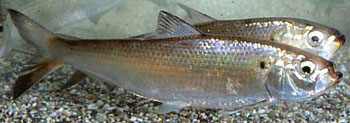Herring Flatwing Streamer
HOOK
|
Eagle Claw 253N #3/0 |
THREAD
|
Red |
TAIL
|
Blend white, pink, light blue bucktail of equal amounts under 1 white neck hackle (curve side up) under 2 pieces of silver flash under 2 white saddles (curve side down) under 2 pieces of red flash under one orange saddle (curve down) uner pink flashabou under one violet saddle (curve side down) under 2 pieces of purple flashabou and one blue flash and under green saddle (curve side down) under 2 pieces of green flash unfer two olive saddles (curve side down) All feathers tied in flat. |
BODY
|
Pearl body
braid |
COLLAR
| Blend long white, pink, light blue bucktail of equal amounts 2/3 around shank |
WING
| Blend long blue and olive bucktail 50/50 |
TOPPING
| Long peacock herl |
EYES
|
Jungle cock |
|
Notes
Time of Appearance: April-May
Adults average 10 to 14 inches in length and weigh less than a pound. Although they look similar to other small herring, their large eyes and deep body easily identify them. Alewives have a short jaw that juts out when the mouth is closed.
Spawning occurs in early spring when large schools of alewives move into tidal waters from the ocean. These spawning runs begin slowly with only a few fish at a time migrating in. As more fish arrive, they remain along the shore in the main rivers. Spawning fish can often be seen swirling about in small groups. Check out the tidal section of Carmans River around Sunrise Highway.
Young alewives are often hard to find, as they hide in weedy beds and deep water during the day. Like shad, as fall approaches they leave the estuary and migrate out to the ocean.
Coloration: Greenish blue on top violet, yellowish shiney sides and pearlescent bottom.
|

